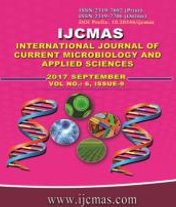


 National Academy of Agricultural Sciences (NAAS)
National Academy of Agricultural Sciences (NAAS)

|
PRINT ISSN : 2319-7692
Online ISSN : 2319-7706 Issues : 12 per year Publisher : Excellent Publishers Email : editorijcmas@gmail.com / submit@ijcmas.com Editor-in-chief: Dr.M.Prakash Index Copernicus ICV 2018: 95.39 NAAS RATING 2020: 5.38 |
In the present study, 15 genotypes of Brassica juncea including white rust resistant and double low quality were characterized and allelic differentiation was determined using 453 SSRs and 139 (30.7%) showed polymorphism with 308 alleles. Polymorphic information content ranged from 0.101 to 0.668, with the average value of 0.474, revealing that much variation was present among these genotypes. The cluster analysis gave three major groups where white rust resistant genotypes were grouped in one major cluster, double low quality genotypes in second cluster while the recipients were grouped in the third cluster indicating that grouping of genotypes based on SSRs corresponded well to their known pedigree data. These observations suggested that SSRs are proficient for evaluating genetic variation and relationships among different varieties of mustard. Further, findings of this study will be useful for DNA fingerprinting, varietal identification which could help during background selection for marker-assisted backcross breeding programs.
 |
 |
 |
 |
 |